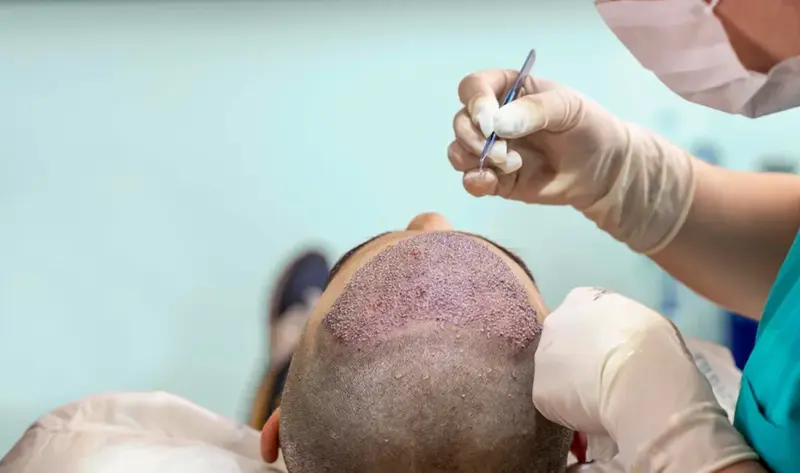Everything You Need to Know About Hair Transplants

Hair is a defining feature of one’s identity, and for many, losing it can be a distressing experience. Thanks to advancements in medical science, hair transplants have become a reliable and transformative solution for those experiencing hair loss. This guide will walk you through everything you need to know about hair transplants, from the basics to the results you can expect.
What Is a Hair Transplant?
A hair transplant is a minimally invasive surgical procedure designed to restore hair in areas affected by baldness or thinning. It involves extracting hair follicles from a donor area (usually the back or sides of the scalp) and implanting them into the recipient area where hair growth is desired.
The transplanted hair grows naturally and blends seamlessly with the surrounding hair, making it one of the most effective and permanent solutions for hair loss.
Why Hair Loss Happens
Hair loss can occur due to various reasons, including:
• Genetics: Male or female pattern baldness (androgenetic alopecia) is the most common cause.
• Hormonal Changes: Conditions like PCOS or thyroid imbalances.
• Stress: Physical or emotional stress can trigger temporary hair shedding.
• Medical Conditions: Alopecia areata, scalp infections, or autoimmune disorders.
• Lifestyle Factors: Poor diet, smoking, or lack of proper hair care.
Understanding the underlying cause of your hair loss is crucial in determining if a hair transplant is the right solution for you.
Techniques Used in Hair Transplants
Hair transplants have evolved significantly over the years. Here are the primary techniques used today:
- FUE (Follicular Unit Extraction): Individual hair follicles are extracted and transplanted to the recipient area.
• Minimally invasive with no linear scars.
• Faster recovery time and natural-looking results. - FUT (Follicular Unit Transplantation): A strip of skin containing hair follicles is removed from the donor area.
• Hair follicles are separated and transplanted.
• Suitable for patients needing a larger number of grafts. - DHI (Direct Hair Implantation): A specialized tool is used to directly implant hair follicles into the scalp.
• Ensures precision and high-density results.
• Ideal for smaller, targeted areas.
Who Is a Good Candidate for a Hair Transplant?
Hair transplants are suitable for individuals who:
• Have stable hair loss (e.g., androgenetic alopecia).
• Possess a sufficient amount of healthy hair in the donor area.
• Are in good overall health.
• Have realistic expectations about the results.
A consultation with a qualified surgeon is essential to assess your hair loss pattern and determine your eligibility.
The Hair Transplant Process
- Consultation: Detailed analysis of your hair loss and scalp condition.
• Discussion of your goals and expectations. - Pre-Surgery Preparation: Avoid smoking, alcohol, and certain medications as advised.
• Your scalp will be cleaned and prepped for the procedure. - Procedure: Local anesthesia is administered for a pain-free experience.
• Hair follicles are extracted and transplanted to the target area.
• The procedure typically lasts 4-8 hours, depending on the number of grafts. - Post-Surgery Care: Follow the surgeon’s instructions for aftercare.
• Avoid strenuous activities and direct sunlight for a few weeks.
• Mild redness or swelling is normal and subsides within days.
What to Expect After a Hair Transplant
Initial Shedding: Transplanted hair may fall out in the first few weeks—this is normal and temporary.
Hair Growth: New hair begins to grow after 3-4 months, with significant results visible within 9-12 months.
Long-Term Results: The transplanted hair is permanent and continues to grow naturally.
Benefits of a Hair Transplant
Permanent Solution: Hair transplants offer lasting results.
Natural Appearance: The transplanted hair blends seamlessly with your existing hair.
Improved Confidence: Restoring your hairline can significantly boost self-esteem.
Low Maintenance: Transplanted hair requires no special care beyond your regular hair care routine.
Common Myths About Hair Transplants
Myth: Hair transplants are painful.
Fact: The procedure is performed under local anesthesia, making it virtually pain-free.
Myth: Results look unnatural.
Fact: Advanced techniques like FUE and DHI ensure natural-looking results.
Myth: Hair transplants are only for men.
Fact: Women experiencing hair loss can also benefit from hair transplants.
Choosing the Right Clinic
Selecting the right clinic is crucial for achieving the best results. Here’s why Alayaa Clinic is a trusted name in hair restoration:
Expertise: Led by Dr. Atul Bhanu, with over 3,500 successful procedures.
Advanced Techniques: Offering FUE, DHI, and PRP therapy for comprehensive solutions.
Global Reach: Trusted by patients from India, Australia, the USA, and more.
Personalized Care: Tailored treatment plans for each patient.
Final Thoughts
A hair transplant is more than just a cosmetic procedure—it’s a journey towards renewed confidence and a better quality of life. With the right surgeon, technology, and aftercare, you can achieve natural and lasting results.
At Alayaa Clinic, we’re here to guide you every step of the way. Schedule a free consultation with me, Dr. Atul Bhanu, and let’s begin your transformation today
